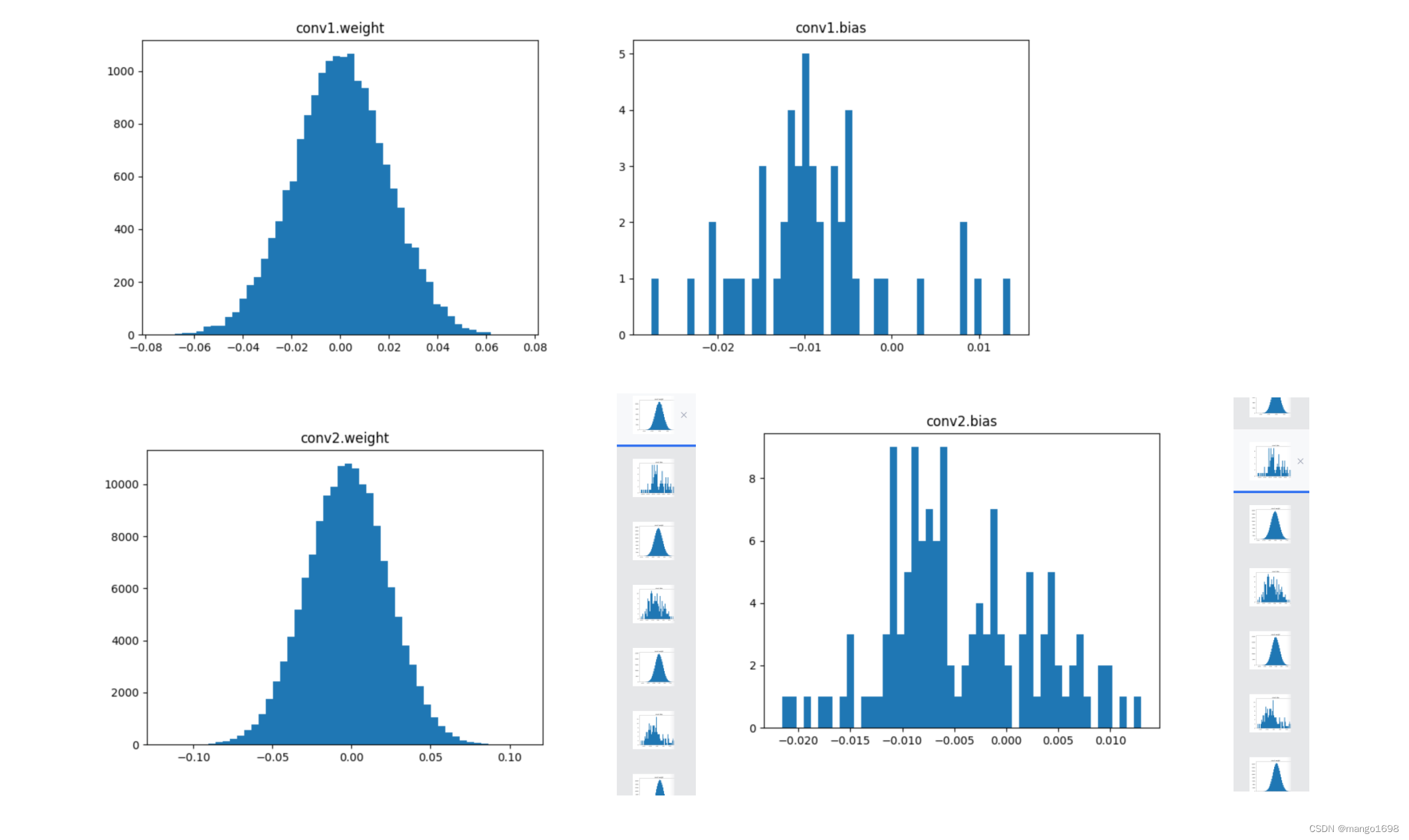查看神经网络中间层特征矩阵及卷积核参数
可视化feature maps以及kernel weights,使用alexnet模型进行演示。
1. 查看中间层特征矩阵
alexnet模型,修改了向前传播
import torch
from torch import nn
from torch.nn import functional as F
# 对花图像数据进行分类
class AlexNet(nn.Module):
def __init__(self,num_classes=1000,init_weights=False, *args, **kwargs) -> None:
super().__init__(*args, **kwargs)
self.conv1 = nn.Conv2d(3,48,11,4,2)
self.pool1 = nn.MaxPool2d(3,2)
self.conv2 = nn.Conv2d(48,128,5,padding=2)
self.pool2 = nn.MaxPool2d(3,2)
self.conv3 = nn.Conv2d(128,192,3,padding=1)
self.conv4 = nn.Conv2d(192,192,3,padding=1)
self.conv5 = nn.Conv2d(192,128,3,padding=1)
self.pool3 = nn.MaxPool2d(3,2)
self.fc1 = nn.Linear(128*6*6,2048)
self.fc2 = nn.Linear(2048,2048)
self.fc3 = nn.Linear(2048,num_classes)
# 是否进行初始化
# 其实我们并不需要对其进行初始化,因为在pytorch中,对我们对卷积及全连接层,自动使用了凯明初始化方法进行了初始化
if init_weights:
self._initialize_weights()
def forward(self,x):
outputs = [] # 定义一个列表,返回我们要查看的哪一层的输出特征矩阵
x = self.conv1(x)
outputs.append(x)
x = self.pool1(F.relu(x,inplace=True))
x = self.conv2(x)
outputs.append(x)
x = self.pool2(F.relu(x,inplace=True))
x = self.conv3(x)
outputs.append(x)
x = F.relu(x,inplace=True)
x = F.relu(self.conv4(x),inplace=True)
x = self.pool3(F.relu(self.conv5(x),inplace=True))
x = x.view(-1,128*6*6)
x = F.dropout(x,p=0.5)
x = F.relu(self.fc1(x),inplace=True)
x = F.dropout(x,p=0.5)
x = F.relu(self.fc2(x),inplace=True)
x = self.fc3(x)
# for name,module in self.named_children():
# x = module(x)
# if name == ["conv1","conv2","conv3"]:
# outputs.append(x)
return outputs
# 初始化权重
def _initialize_weights(self):
for m in self.modules():
if isinstance(m,nn.Conv2d):
# 凯明初始化 - 何凯明
nn.init.kaiming_normal_(m.weight, mode='fan_out', nonlinearity='relu')
if m.bias is not None:
nn.init.constant_(m.bias, 0)
elif isinstance(m,nn.Linear):
nn.init.normal_(m.weight, 0,0.01) # 使用正态分布给权重赋值进行初始化
nn.init.constant_(m.bias,0)
拿到向前传播的结果,对特征图进行可视化,这里,我们使用训练好的模型,直接加载模型参数。
注意,要使用与训练时相同的数据预处理。
import matplotlib.pyplot as plt
from torchvision import transforms
import alexnet_model
import torch
from PIL import Image
import numpy as np
from alexnet_model import AlexNet
# AlexNet 数据预处理
transform = transforms.Compose([
transforms.Resize((224, 224)),
transforms.ToTensor(),
transforms.Normalize((0.5, 0.5, 0.5), (0.5, 0.5, 0.5))
])
device = torch.device("mps" if torch.backends.mps.is_available() else "cpu")
# 实例化模型
model = AlexNet(num_classes=5)
weights = torch.load("./alexnet_weight_20.pth", map_location="cpu")
model.load_state_dict(weights)
image = Image.open("./images/yjx.jpg")
image = transform(image)
image = image.unsqueeze(0)
with torch.no_grad():
output = model(image)
for feature_map in output:
# (N,C,W,H) -> (C,W,H)
im = np.squeeze(feature_map.detach().numpy())
# (C,W,H) -> (W,H,C)
im = np.transpose(im,[1,2,0])
plt.figure()
# 展示当前层的前12个通道
for i in range(12):
ax = plt.subplot(3,4,i+1) # i+1: 每个图的索引
plt.imshow(im[:,:,i],cmap='gray')
plt.show()
结果:

2. 查看卷积核参数
import matplotlib.pyplot as plt
import numpy as np
import torch
from AlexNet.model import AlexNet
# 实例化模型
model = AlexNet(num_classes=5)
weights = torch.load("./alexnet_weight_20.pth", map_location="cpu")
model.load_state_dict(weights)
weights_keys = model.state_dict().keys()
for key in weights_keys:
if "num_batches_tracked" in key:
continue
weight_t = model.state_dict()[key].numpy()
weight_mean = weight_t.mean()
weight_std = weight_t.std(ddof=1)
weight_min = weight_t.min()
weight_max = weight_t.max()
print("mean is {}, std is {}, min is {}, max is {}".format(weight_mean, weight_std, weight_min, weight_max))
weight_vec = np.reshape(weight_t,[-1])
plt.hist(weight_vec,bins=50)
plt.title(key)
plt.show()
结果:




